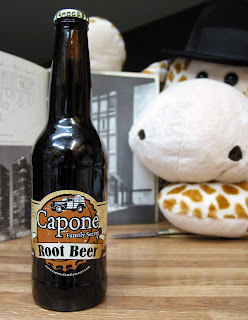Yes indeed, it's probably high time I finish my root beer cataloging from our road trip. I have a legitimate excuse for my delay this time (assuming my day job isn't normally legitimate enough excuse...) since the reason for our road trip decided to make his break for it a little earlier than expected. And while things are probably never going to settle down ever again (for the next 25 years or so, at any rate...), I'm finally at least able to surface a little to enjoy the last of our trip's acquisitions.
Central Coast Brewing first opened in 1998 with a stated goal to not only produce quality beverages, but to do so with the smallest carbon footprint possible. To that end, owner George Peterson has implemented a number of green business practices, including using production gray water to clean fermentation tanks and irrigate landscaping outside the brewery/tasting room, working with local utility companies to convert alcohol waste into bio-fuel, and limiting distribution to within 30 miles where many deliveries can still be made by bicycle. Peterson even runs his operation using recycled equipment collected from far and wide, northward to Washington and southward to Nicaragua (source). Following the same tack, when expanding demand meant replacing his equipment with larger (also second-hand) gear, Peterson sold his old gear to Pismo Brewing, the fruits of which we just covered a couple posts ago (source). Business has been good for Central Coast Brewing, which now produces at least 10 different ales, IPAs, seasonals, and stouts at any given time as well as, of course, the root beer, and operates a mobile kegger converted from an old restored Brazilian refrigerated catering truck that Peterson found on Craigslist (source).
The root beer isn't really one of my favorites, but it's still a pleasant drinking experience. It's dark and opaque, with a full body that's not too thick and not too thin. While it smells pretty sugary and only thinly of root beer, it actually doesn't taste too sweet at all, though the root beer flavor is actually a little thin and not particularly distinctive – maybe a little clove on the back end with a very, very slight menthol aroma. Flavors don't really build further into the ample 22 oz bottle and there's no real aftertaste to speak of, so it tastes relatively uniform throughout. Carbonation bubbles are somewhere north of medium but south of large, building to a rather large head that's all bubble and no foam, which therefore doesn't last long. But again, although unremarkable, Central Coast Brewing’s Root Beer is still a pleasant drinking experience.
Speaking of something to experience, the Central Coast shop is a sight to behold, with a bottle collection of magnitude I can only dream of one day achieving.
As far as Central Coast Brewing's Root Beer goes, I'll give it a low 3.5.

.JPG)




.JPG)





.jpg)
.jpg)







.JPG)

.JPG)

.JPG)
